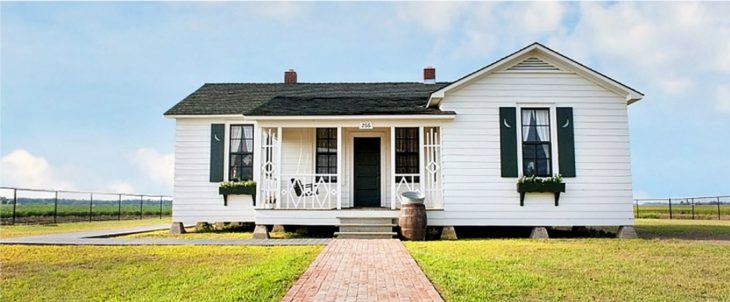Johnny Cash home added to National Historic Registry as new renovations are underway
by May 10, 2018 7:13 pm 1,031 views

The restored Cash home in the Dyess Colony.
Dr. Ruth Hawkins spent many years roaming the gravel roads and out-of-the-way places in the Arkansas Delta searching for ways to increase tourism in the region. Hawkins, the executive director of the Arkansas State University Heritage Sites program, passed by Johnny Cash’s boyhood home many times.
Occasionally, she would see a tourist taking a picture at the home near the town of Dyess in rural Mississippi County. It disturbed her each time she witnessed tourists at the home. It was dilapidated, and she thought it was a shame that people coming to the house thought that Cash grew-up in such poor conditions. When his family moved into the house, it was brand new. His mother sat on the floor and cried after the paint dried because it was the first new floor she’d ever lived upon.
The house has been restored and was recently added to the National Register of Historic Places, Hawkins told Talk Business & Politics. Plans are underway to build or move a smokehouse, outhouse and chicken coop onto the property, she said. Organizers hope to have the three out buildings completed before the Johnny Cash Festival held each October. It’s one of the ASU Heritage Sites.
“The house … it had seen better days,” she said.
How the Cash family came to this desolate spot in rural Northeast Arkansas was a common story during a harsh bit of American history. Drought, sporadic floods, and the Great Depression decimated family farms in the early 1930s. President Franklin Roosevelt started what was then called a socialistic plan to help many of these farmers in eastern Arkansas.
Ray and Carrie Cash brought their family to the Dyess Colony in 1935, according to historians. The Cashes moved to Dyess with their five children, Roy, 13; Louise, 11; Jack, 5; J.R., 3; and Reba, 1. Joanne and Tommy were born in Dyess Colony as it was called.
During that era, the area was more swamp than usable farm ground. Workers drained the swamp and 500 farm families, including the Cash family received 40 acres and a mule through a federal government aid program. Rice and cotton were grown. Johnny Cash, along with his brother, Jack, worked the family farm and attended school. The family remained there for several years after Cash left to become a world famous musician.
Hawkins passed by the house for years, but it wasn’t until 2009 that a serious attempt began to buy and restore the house, she said. Dyess city officials approached ASU and asked the university to partner in the restoration of the administrative building. It was around this time talks started with the house owner, she said. About $1.5 million in grants were procured to restore the administration building, and museum exhibits were placed inside.
In 2011, the house and a third of an acre were bought for $100,000, Hawkins said. The first objective was to rebuild the house’s foundation. This part of Mississippi County has a lot of “gumbo soil,” and it shifts, often, Hawkins said. The concrete piers that supported the house had moved, and it was virtually on the ground. The native soil was removed and replaced with better drainage soil, she said. A concrete foundation was poured and piers were placed on top of the foundation to give the house its original appearance, she said.
“That was a major ordeal,” she said.
Once the foundation was set, their attention turned to the inside of the house. Tommy and Joanne returned and with pain-staking detail told the restoration team how the house looked during their childhood. A digital model was created. Some original Cash home items were located, such as the family piano, but many household items from that era would have to be found. An online registry was established, similar to a bridal registry, Hawkins said. Slowly but surely, the house began to round into the shape it was when the Cash family lived there, she said.
“It was a wonderful process,” she said.
The house and administrative building were opened in 2014. A visitor’s center built as part of the old Dyess Colony movie theater was erected. The total cost of the entire project was a little more than $4 million, Hawkins said. A lot of the restorations were paid for with grants, but the entire house project, $575,000, was paid with proceeds from the festival and private donations, she said.
“The house was funded by Johnny Cash friends,” she said.
The out buildings are the next project, she said. A smokehouse from that era has been located and can be moved to the site. A chicken coop has been located too, but it’s in such bad condition it can’t be moved, she said. It gives them an idea of what they need to build, she said. How much these out buildings will cost is hard to tabulate at this point because they don’t know what they’ll need to build or how much it may cost to move an original building.
There are plans to build an original barn on the property. It will look like a barn on the outside, but on the inside it will be furnished to hold conferences, seminars, and other meetings. A timetable and budget for the barn has not been established.
Published reports have stated the Cash family may build his archives in Tulsa. If the family does establish his archives in Oklahoma, Hawkins doesn’t expect it to have an impact on the Dyess site. Up to 25,000 visitors come to the house each year, and the numbers continue to grow, she said.
“We’re focused on his childhood and his life in Arkansas,” Hawkins said.
